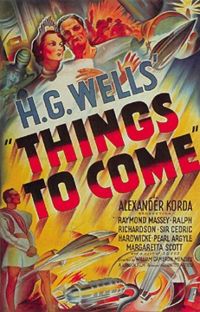 One of the pioneering "fathers of science fiction," author H.G. Wells (1866-1946) published a visionary chronicle of the future in 1933 entitled The Shape of Things to Come.
One of the pioneering "fathers of science fiction," author H.G. Wells (1866-1946) published a visionary chronicle of the future in 1933 entitled The Shape of Things to Come.As fascism rose across a continent like a dark tide, as economic depression savaged our nation, this stirring, creative (and fictional) account of world events from 1933 to 2100 offered the detailed imaginings of a committed Anti-Marxist socialist; one who accurately predicted many elements of our world today.
In his fictional account of "things to come," author Wells foresaw weapons of mass destruction (chemical "air torpedoes"), submarine-based missiles, the rise of Warlord-ism, the Blitz (and ensuing destruction of London), World War II, the
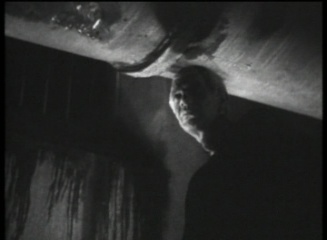 invasion of Poland, "surgical" missile strikes, and much more.
invasion of Poland, "surgical" missile strikes, and much more.Wells also envisioned other events: a world war lasting for thirty years, followed by a deadly plague ("The Wandering Sickness"), and then, the rise of a World State...and the end of nationalism.
In his future world, Wells' benevolent dictatorship eliminated not merely nationalism (and nation states), but organized religion. His conquering regime controlled the survivors of the human race through advanced technology, particularly mass transportation (planes). This World State also included the idea of advancement in society by intellectual merit, not by family name (like, say Bush?), class, or wealth. Finally, Wells saw the overthrow of the dictatorial World State after a hundred years...and a new age of technological progress beyond.
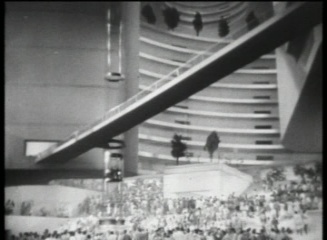
Alexander Korda and director William Cameron Menzies collaborated with Wells to bring this startling, prophetic vision of man's future to the silver screen in 1936. The film, Things to Come, has earned the title "classic" as well as the descriptor "visionary," and rightly so. It is one of the genre's earliest and most awe-inspiring masterpieces, not to mention a special-effects stunner. I first saw it when I was a teenager- -- cut up for commercial television -- and have read about it in probably every science fiction film book in history. It's an important, landmark film in terms of genre, in terms of content, and also in terms of special effects technology.
Things to Come's central plot is divided into three portions or Ages. There is the pre-War Age (set in 1936). There is the immediate aftermath of War (set in 1966-1967) and the beginning of the Worl
 d State, and then a future Age of Progress (set in 2036).
d State, and then a future Age of Progress (set in 2036). Each of these three sections is centered in a fictionalized version of London called "Everytown." And, to one extent or another, each passage also revolves around one family countenancing the inexorable winds of change; the Cabal family. This personal, identifiable element of family makes the film a sort of "generational" tale, and more easily approachable in terms of narrative. Raymond Massey stars as John Cabal in the first two portions of the film; and as leader Oswald Cabal in the Age of Progress section.
Our story commences in Everytown on Christmas Eve, 1936. John Cabal is a pessimistic brooder who believes war is inevitable, and worse, that it is impending. His friends and family members, including a young doctor, Harding, don't want to see war "mess things up," and resist the idea of war's inevitability. Cabal mulls over man's nature with grim fortitude. "We must end war. Or war will end us," he states.
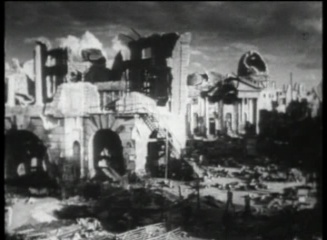
Soon after this introduction to the characters, Things to Come depicts a happy Everytown by nightfall, at least until a truck with a white placard bearing the legend WAR SCARE appears in the background of a frame, in plain sight. In this portion of the film, we get a rapid-fire montage of several such war-themed placards until - still on Christmas Eve - war breaks out. Cabal was right...nothing could stop the conflagration of destruction. That very night, Everytown is bombed from the air in scenes eerily reminiscent of the Blitz (though they were shot years before...).
Before our eyes, we see a local cinema explode and crumble, a sign that the age of man's technology and leisure is at an end. As destruction rains from the sky, Menzies cuts to an image of a young blond boy - no more than ten years old, perhaps - wearing a soldier's helmet. The child -- apparently knowing what is to come -- begins to march like a "real" soldier. After a few seconds of lingering on this image, Menzies superimposes new images (silhouettes, actually...) of adult soldiers on the march; juxtaposing play and reality; indicating that even the young will be conscripted into the never ending conflict. And indeed they are: the war lasts for a generation. In 1960, it ends....but only because so few people are left.
Worse, pestilence follows. In the burned out city of Everytown ("a cursed ruin of a town," as one character describes it) in 1966, a disease called the Wandering Sickness takes hold. Those who contract the illness are shot on sight. By 1967 half the human race is extinguished, and society attempts to re-build...in vain.
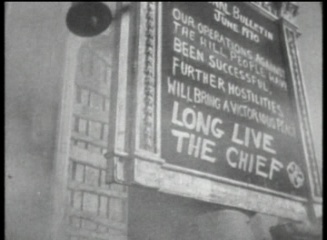
Everytown, for instance, comes under the corrupt leadership of "The Boss" (or "The Chief") played by Ralph Richardson, a warlord who quickly launches a new military offensive against neighbors called The Hill People. Since there is no longer radio, cinema or even newspapers, The Chief sees his propaganda scrawled crudely on a board displayed before the ruins of City Hall. On this board, the Chief promises "victorious peace" after the Hill People are conquered. But winning the war isn't easy, and the Chief knows what he needs to win: working airplanes. His chief engineer, Richard Gordon, can't promise him anything. "We shall never get in the air again," he laments. "Flying is finished."
Yes, it appears to be a Dark Age for mankind as Everytown runs short on medical supplies (where Dr. Harding -- much older -- serves as the local physician), and where knowledge of aeronautics and machinery seems ready to slip away forever...

But then, one day -- out of the clear blue sky -- a highly-advanced plane arrives in Everytown. The pilot is a gray-haired John Cabal, making a homecoming of sorts. He now serves in "Wings over the World," an organization of scientists and engineers dedicated to restoring trade and civilization to the area of the Mediterranean. Cabal's mission is also to stop "petty dictators" and bring an end to independent, sovereign states...the end of Nationalism. The Chief naturally resists, and has Cabal arrested and thrown in jail.
In a short time, however, Wings over the World arrives in force (in giant flying fortresses -- another prophetic idea from Wells), and bombs Everytown with the harmless "Gas of Peace." There is only one casualty in the attack: the Chief himself, who conveniently has suffered a heart attack. "He's dead and his world died with him," opines Cab
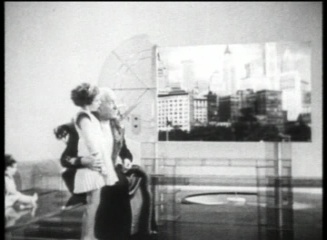 al without pity, as the black-suited members of Wings over the World descend on Everytown by parachute. "Now...for a new life for mankind."
al without pity, as the black-suited members of Wings over the World descend on Everytown by parachute. "Now...for a new life for mankind."After a lengthy interlude during which vast machines building an advanced underground city, we skip ahead to the subterranean Everytown of 2036. Oswald Cabal is the leader of the city now (grandchild of John), but faces an insurrection from anti-progressives (conservatives?) who fear that progress has gone too far; that technology is out-of-control and once again threatening the safety and peace of man. Exhibit A in their argument is the vast Space Gun -- a giant device that is primed to "fire" a rocket to the moon. Cabal plans to send his daughter, Katherine, and her boyfriend, there, to prove that human progress is unstoppable, limitless.

"We demand a rest," argues the leader of the anti-progressives on a giant, city-size view screen (seen by thousands of citizens). "The purpose of life is happy living!" Cabal doesn't hinder the speech (a fact which promises a world of free speech and free expression, at least...). Instead, he trusts that his people will be wise about the future. "They'll have to hear him," says Cabal. "They'll have to hear him and make of it what they can..."
In the end, progress marches on, and the rocket is fired into space. Gazing out into space via a telescope, Cabal debates the future of the human race with an anxious friend, one who sympathizes with the anti-progressiv
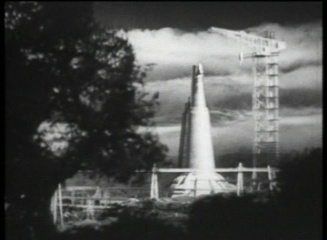 e movement. Is mankind ever to stop moving forward? What comes after the moon? After the stars? At this interrogative, Cabal deplores the "ugly spectacle of waste" that represented warfare in the twentieth century, and says that progress, technology and wisdom -- the push into the future -- has made "danger and death worthwhile" and that the human adventure is only beginning. Mankind he believes, must "go on; conquest after conquest." The choice is as simple as "all the universe or nothing."
e movement. Is mankind ever to stop moving forward? What comes after the moon? After the stars? At this interrogative, Cabal deplores the "ugly spectacle of waste" that represented warfare in the twentieth century, and says that progress, technology and wisdom -- the push into the future -- has made "danger and death worthwhile" and that the human adventure is only beginning. Mankind he believes, must "go on; conquest after conquest." The choice is as simple as "all the universe or nothing."The film ends with a stirring, dramatic question from Oswald Cabal to his friend (and to us, in the audience.) "Which shall it be?"
That's a good and highly relevant question in these
 turbulent times of terrorism and warfare. The element I admire most about Things to Come is this pervasive. thorough and committed anti-war message. It seems to me that Wells, Korda and Menzies get this element precisely right.
turbulent times of terrorism and warfare. The element I admire most about Things to Come is this pervasive. thorough and committed anti-war message. It seems to me that Wells, Korda and Menzies get this element precisely right.What could mankind do -- what could we accomplish -- if we didn't squander our blood, our youth, our treasure, and our science on killing, on war? The sky - nay the stars themselves - would be the limit.
I absolutely believe this is accurate, and often point out that every citizen in America could have had free health care for the last several years with the money we have wasted fighting the Iraq War. (And by the way -- Iraqis
 already have universal health care It's good enough for them, but not us, apparently.) And better yet -- nobody would have died. This is just one real life example of how war destroys or severely limits man's progress and opportunity.
already have universal health care It's good enough for them, but not us, apparently.) And better yet -- nobody would have died. This is just one real life example of how war destroys or severely limits man's progress and opportunity.Wells also (rightly) predicted that for every advance in science that man forges, there is blow back; a counter-movement of men who want to take us "back" to an earlier era; who desire to believe in old superstitions and myth rather than utilize science to scale new heights. We see it now in the anti-intellectual movement that flourishes in this country today.
Nor is it difficult to understand why Wells has targeted nationalism and religion for extinction in his utopia of the future. As long as we divide ourselves into little teams (Democrats, Republicans, Christians, Muslims, Jews, liberals, conservatives, gays, straights, Marvel, DC, etc.) he believes we won't work together for the common good. It's not enough, apparently, that we're all human beings, or all citizens of planet Earth. Look, for exa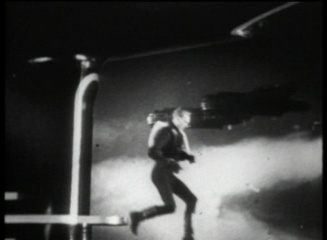 mple, at what nationalism has done to America in the last eight years. We Americans were so mad (and so scared...) after being attacked on September 11th that we angrily...invaded the wrong country. And we did so largely on the basis of patriotic arguments. Oopsy...
mple, at what nationalism has done to America in the last eight years. We Americans were so mad (and so scared...) after being attacked on September 11th that we angrily...invaded the wrong country. And we did so largely on the basis of patriotic arguments. Oopsy...
Yet what I find deeply troubling about Things to Come is this Wellesian notion of a World dictatorship - benevolent or otherwise. Look at the scenes in the film featuring The Wings over the World air men -- strangely faceless and identical -- swarming through Everytown in their spiffy black uniforms. This is just another face of fascism, isn't it? These men arrive, utilize weapons (even the harmless "gas of peace" is technically a weapon...), and then impose their will on the citizenry using superior technology. Now, these men would tell you they are doing what's best for mankind. But I would argue that's the sa me point every dictator in history has likely made. Who knows what's best for mankind? Who chooses? The point, I suppose, is that human beings should be free to choose for themselves how they live; not have a particular ideology - even progress - forced down their throats. Or am I wrong? Do we need a strong man to point us to the light?
me point every dictator in history has likely made. Who knows what's best for mankind? Who chooses? The point, I suppose, is that human beings should be free to choose for themselves how they live; not have a particular ideology - even progress - forced down their throats. Or am I wrong? Do we need a strong man to point us to the light?
Whatever the eventual form, Things to Come is spot on, I suggest, with this prediction of a World State. In our world, however, I believe it is likely to be a corporate world state, not a socialist one. There are steps being taken towards that today, and frankly, it frightens me...a lot. Also, though I sympathize with Wells, I believe his socialist sympathies made him misunderstand human nature. Here's an example: In his vision, man reaches the moon in 2036, after a uniform World State is in charge; after nationalism is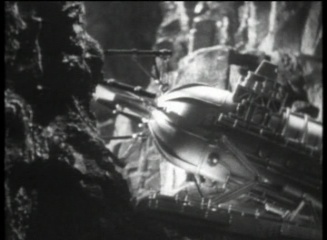 long dead. In our world, by explicit contrast, it was nationalism -- the Cold War with the Soviet Union -- that spurred the space race. We made it to the moon in 1969, because of the need to compete; the need to beat Russia, right? So I can see both sides of the nationalism debate. It can be good (moon landing) or bad (Iraq War), I suppose. But just let me make this point: as far back as Athens and Sparta, nation states competed...and the competition brought about great art, great science and great literature, no?
long dead. In our world, by explicit contrast, it was nationalism -- the Cold War with the Soviet Union -- that spurred the space race. We made it to the moon in 1969, because of the need to compete; the need to beat Russia, right? So I can see both sides of the nationalism debate. It can be good (moon landing) or bad (Iraq War), I suppose. But just let me make this point: as far back as Athens and Sparta, nation states competed...and the competition brought about great art, great science and great literature, no?
Things to Come is a brilliant film filled with fascinating ideas, but some do clearly border on the simplistic. Cabal is ruthless...but well-intentioned. What if another man in that position was not so well-intentioned? That is a question that Wells doesn't get around to answering here. (It's the same question, by the way, that Dark Knight ignores).
Technology-wise, this film features extraordinary miniatures and blends them deftly with live-action sequences. The views of the Everytown cityscape of 2036 remain breathtaking and awe-inspiring. Some of the miniature war footage (of tanks rolling across barren wastelands) is virtually indistinguishable from stock footage. The aerial footage also appears remarkably real. This is amazing for a film released seventy-two years ago. It is ironic, however: Things to Come imagined a world where technological devices would become vast, colossal; in the real world, we've experienced a revolution of miniaturization instead.
Finally, the last moments of the film will remain with you, along with Cabal's probing question. The universe? Or nothing? Which shall it be? More importantly, if it's the universe, how do we find our way to that future? Benevolent dictatorship? United Federation of Planets? Global free trade?
Anyone?
 mple, at what nationalism has done to America in the last eight years. We Americans were so mad (and so scared...) after being attacked on September 11th that we angrily...invaded the wrong country. And we did so largely on the basis of patriotic arguments. Oopsy...
mple, at what nationalism has done to America in the last eight years. We Americans were so mad (and so scared...) after being attacked on September 11th that we angrily...invaded the wrong country. And we did so largely on the basis of patriotic arguments. Oopsy...Yet what I find deeply troubling about Things to Come is this Wellesian notion of a World dictatorship - benevolent or otherwise. Look at the scenes in the film featuring The Wings over the World air men -- strangely faceless and identical -- swarming through Everytown in their spiffy black uniforms. This is just another face of fascism, isn't it? These men arrive, utilize weapons (even the harmless "gas of peace" is technically a weapon...), and then impose their will on the citizenry using superior technology. Now, these men would tell you they are doing what's best for mankind. But I would argue that's the sa
 me point every dictator in history has likely made. Who knows what's best for mankind? Who chooses? The point, I suppose, is that human beings should be free to choose for themselves how they live; not have a particular ideology - even progress - forced down their throats. Or am I wrong? Do we need a strong man to point us to the light?
me point every dictator in history has likely made. Who knows what's best for mankind? Who chooses? The point, I suppose, is that human beings should be free to choose for themselves how they live; not have a particular ideology - even progress - forced down their throats. Or am I wrong? Do we need a strong man to point us to the light?Whatever the eventual form, Things to Come is spot on, I suggest, with this prediction of a World State. In our world, however, I believe it is likely to be a corporate world state, not a socialist one. There are steps being taken towards that today, and frankly, it frightens me...a lot. Also, though I sympathize with Wells, I believe his socialist sympathies made him misunderstand human nature. Here's an example: In his vision, man reaches the moon in 2036, after a uniform World State is in charge; after nationalism is
 long dead. In our world, by explicit contrast, it was nationalism -- the Cold War with the Soviet Union -- that spurred the space race. We made it to the moon in 1969, because of the need to compete; the need to beat Russia, right? So I can see both sides of the nationalism debate. It can be good (moon landing) or bad (Iraq War), I suppose. But just let me make this point: as far back as Athens and Sparta, nation states competed...and the competition brought about great art, great science and great literature, no?
long dead. In our world, by explicit contrast, it was nationalism -- the Cold War with the Soviet Union -- that spurred the space race. We made it to the moon in 1969, because of the need to compete; the need to beat Russia, right? So I can see both sides of the nationalism debate. It can be good (moon landing) or bad (Iraq War), I suppose. But just let me make this point: as far back as Athens and Sparta, nation states competed...and the competition brought about great art, great science and great literature, no?Things to Come is a brilliant film filled with fascinating ideas, but some do clearly border on the simplistic. Cabal is ruthless...but well-intentioned. What if another man in that position was not so well-intentioned? That is a question that Wells doesn't get around to answering here. (It's the same question, by the way, that Dark Knight ignores).
Technology-wise, this film features extraordinary miniatures and blends them deftly with live-action sequences. The views of the Everytown cityscape of 2036 remain breathtaking and awe-inspiring. Some of the miniature war footage (of tanks rolling across barren wastelands) is virtually indistinguishable from stock footage. The aerial footage also appears remarkably real. This is amazing for a film released seventy-two years ago. It is ironic, however: Things to Come imagined a world where technological devices would become vast, colossal; in the real world, we've experienced a revolution of miniaturization instead.
Finally, the last moments of the film will remain with you, along with Cabal's probing question. The universe? Or nothing? Which shall it be? More importantly, if it's the universe, how do we find our way to that future? Benevolent dictatorship? United Federation of Planets? Global free trade?
Anyone?




An excellent review with some new ways of looking at the film. I hadn't seen "Things to Come" in over twenty years until TCM showed it last year. The film still impressed me in some respects, while disappointed in others. The acting just seemed so wooden. The dialogue wasn't very naturalistic (given to grandiose speechifying), but I don't think that is what Wells was aiming for. The prediction of a decades-long war probably seemed like a very logical extrapolation by Wells from the experinces of WWI.
ReplyDeleteNot all of the effects hold up today... such as transparent debris falling upon people during the bombing of Everytown. The undetailed tank models roaming the battlefields look very toy-like. The hanging miniatures used for Everytown 2036 are spectacularly effective. The helicopter, Cabal's plane and fleet are timelessly cool designs.
Some of the film's lines were just plain silly such as showing Manhatten as an example of man's need to build into the sky for light. Hello, but the electric lightbulb had been in use for decades when Wells typed that up. Subways don't need to be built above ground for light, and cities don't grind to a halt because of night. And as for the Space Gun- instant death for the passengers upon firing. Well's could have learned from Lang's earlier silent "Frau im Mond" with its more accurate depiction of rocket travel.
Recently in the video store, I saw that a brand new colorised version of the film is available. I think Ray Harryhausen is one of the people providing commentary on the new DVD. It's easy to see how "King Kong" and "Things to Come" impressed the teenage Harryhausen in the 1930's. The films are still quite impressive over 70 years later!
I took the old man's remarks about "sticking buildings up into the daylight" as just a simple way of explaining skyscrapers to his young great-granddaughter. But the Space Gun -- WTF was Wells thinking? That concept, borrowed from Jules Verne, was long outdated by the time the film was made.
ReplyDeleteAnd please avoid the colorized version. It looks absolutely god-awful.